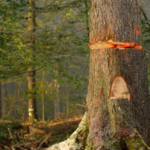As the hurricane season approaches, it is crucial to ensure that your trees are prepared to withstand the potential impact of strong winds, heavy rainfall, and other destructive forces.
By taking proactive measures, you can minimize the risks associated with falling branches or uprooted trees during storms. In this blog, we will provide you with valuable insights and practical tips for effectively preparing your trees for the upcoming hurricane season.
- Assess and Inspect: Before hurricane season arrives, it’s essential to conduct a thorough assessment of your trees’ health and stability. Look for signs of disease, decay, or structural weaknesses such as cracks, splits, or leaning. Inspect the tree trunks, branches, and root systems for any abnormalities that could increase the likelihood of damage during a hurricane.
- Trim and Prune: Regular tree maintenance, including pruning and trimming, is crucial for promoting tree health and reducing the risk of damage during a storm. Prune dead or weak branches, as they are more prone to breakage. Focus on maintaining a well-balanced canopy, ensuring that branches are not overcrowded or too close to structures like your house or power lines.
- Reinforce Weak Branches: Identify any weak branches that could potentially break under the stress of high winds. Consider installing tree cables or bracing rods to strengthen these branches, providing additional support and stability. Consult with a professional arborist to determine the best approach and ensure proper installation.
- Proper Tree Planting: If you’re considering planting new trees, choose species that are more wind-resistant and well-suited to your region. Deep-rooted trees, such as oaks and conifers, tend to be more stable during hurricanes. Ensure that you plant trees at the appropriate distance from structures, allowing enough space for their full growth potential without causing any potential damage.
- Secure Loose Items: Remove or secure any loose items around your trees that could become projectiles during high winds. Patio furniture, garden tools, and decorations should be properly stored or secured to prevent them from causing damage to your trees or nearby structures.
- Mulching and Fertilization: Maintaining healthy trees is essential for their ability to withstand storms. Apply a layer of organic mulch around the base of your trees to help retain moisture, regulate soil temperature, and improve overall tree health. Additionally, consider fertilizing your trees with a slow-release fertilizer, providing them with the necessary nutrients to promote growth and resilience.
- Watering: Proper watering practices are essential for tree health and vigor. Ensure that your trees receive adequate water, especially during dry periods leading up to hurricane season. Well-hydrated trees are more likely to withstand the stress of strong winds and recover more quickly if damage occurs.
- Professional Consultation: When in doubt or if you have concerns about the stability of your trees, consult with a professional arborist. They can provide expert advice, assess tree health, and recommend appropriate actions to minimize the risk of damage during hurricanes.
Conclusion: By following these tips for tree preparation for hurricanes, you can significantly reduce the risks associated with hurricanes. Taking proactive measures such as assessing tree health, pruning, reinforcing weak branches, and consulting with professionals will ensure that your trees are better equipped to withstand the upcoming hurricane season. Remember, tree preparation is a crucial step in safeguarding your property and ensuring the safety of those around you. Stay prepared, stay safe!



